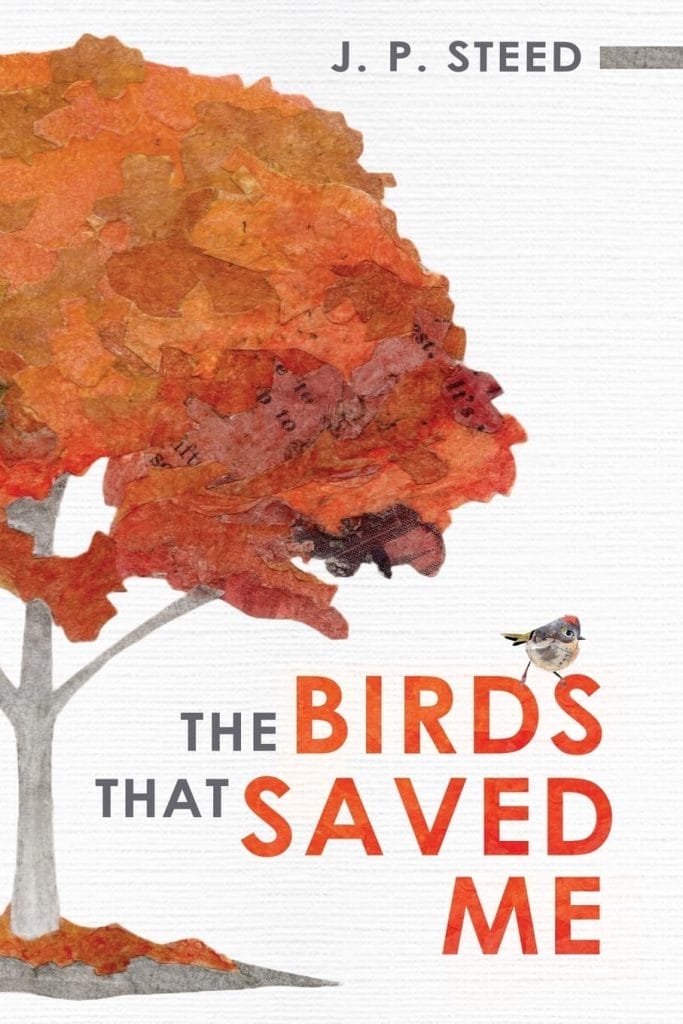By Michele T Logarta
While field guides are essential to birding, there are many other tomes of interest to the bird watching bookworm. This section features those other books, fiction and nonfiction, about birds, birders, nature, and the environment. For this issue of eBon, I chose the book The Birds that Saved Me by J.P. Steed.

The Birds that Saved Me
By J.P. Steed
With Artwork by Norah Steed
Published by GHOW Press (2023)
Non Fiction
Author J.P. Steed, like many new birders today, was a pandemic birder. The back cover of the book tells us that he and his family were already struggling with many difficulties in life—trauma, death, depression—when COVID-19 struck. To cope, Steed sought the healing power of outdoors and discovered birds during his daily walks to a nearby creek in his neighbourhood in the Texas county of Collins. In this book, he writes about the birds that saved him during those dark days.
The Birds that Saved Me is described as “part memoir, part self help guide, part introduction to birds and birding, a richly layered meditation on life—a book about finding the good things that will help us survive the hard things.”
The book is divided into four sections, named after the four seasons. Each section offers essays, each focusing on a single bird and lesson it taught or insights it gave the author.
The book begins with Fall and opens with an ode to Steed’s spark bird. All of us birders know how our respective spark birds transformed us. A spark bird is an epiphany, truly. For the author, it was the Pileated Woodpecker that changed him into the birder he is today.
Here is what he said on that experience of meeting his spark bird:
“It was marvellous. That night in bed I kept marvelling over it. How was I—a 48 year old man—only just now seeing this bird? I had heard that sound in the woods so many times, for so many years—how did I not know it was a bird? And it was so beautiful! I was so thrilled to know that it existed! How did I not know, until now that it existed?”
The author likened this moment to other moments of realization in his life. It was a like a light had come on and illuminated dark corners in his life that he had not understood.
“The Pileated Woodpecker became for me a symbol of midlife enlightenment. A symbol for suddenly seeing clearly for the first time, that which had been there all along.”
According to Steed, there are two kinds of mistakes birders often make. The first kind is mistaking a common bird for a rarity. It could be, at times, wishful thinking! The second is the reverse; dismissing a rarity for a common one.
We often dismiss the Eurasian Tree Sparrow as a trash bird. It is always worthy of a second look. Who knows it might now be the trash bird we think it is?
He cited the Blue-headed Vireo as his favorite—a bird which he saw three times during his first year of birding, but never got a good look at. Mistaking it first for a Kinglet, he didn’t realize he had photographed a Vireo until much later, as he scoured through his pictures and saw the bird’s “stark-white spectacles.”
The Blue-headed Vireo, said Steed, is beloved to him because it is a reminder for him to question long-held assumptions. To take a second look and to look again and again more closely—at birds and other things in life—would be wise to do.
“We will never see what’s rare and special about the present moment, about this current experience, or about the particular person who is standing right in front of us,”said Steed, if we don’t take that second or third look.
The Orange-crowned Warbler is a common bird. But, Steed had never seen one, even after completing 273 bird walks. One day, he brought home a fallen log to convert it into a bird feeder. Lo and behold, a new bird came into his garden. What else could it be but the elusive warbler! He named her Mabel.
“From Mabel,” the author said, “I learned you don’t always have to chase after the good things. Sometimes, it’s better to stay home. Tend to your own backyard. If you do that, then sometimes—instead of having to chase after the good things—the good things will come to you.”
This reminds me of the early days of COVID-19 when it was its most terrifying. The birds did come to us as we hunkered down in our homes —sparks of divinity, flashes of beauty that brought awe and delight, bringers of the peace of wild things that poet Mary Oliver spoke of. For many people, the time of lockdowns was a time of rediscovery of the things that mattered.
Steed’s book make readers like me wonder—What do the birds teach me?
###
